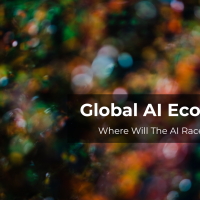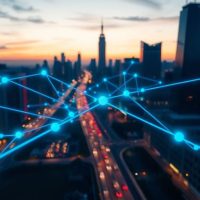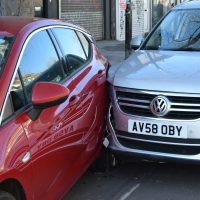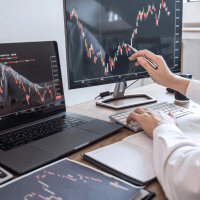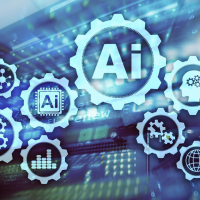Circular Economy, Blockchain Disruption Challenges
Introduction
The present global economy is driven by non-linear economic models based on multiple technologies and energies that have a considerable number of dysfunctionalities and contradictions. We live in a world shaped by an original Marxist economic model that developed itself into a socialist centralised model, which coexists now with a (paradoxically) neo-liberal technology hyper-capitalist model. The current system is complex, fragmented, and deeply bipolar, something which affects most of the governments in practice.
The challenge is that all of these models are increasingly dependent on energies that are not sustainable and the digital centralised technologies that make them happen. The global economy, with all its paradoxes, is based on energies developed in the last 200 years (energies such as coal and oil) and more recently, 50 years of digital technologies (technologies, digital models, processors hardware and software).
But the rhythm of change and disruption is bigger than ever in the history of humankind. What we are going to see over the next 10 years with blockchain disruption, AI and IOT will be key. Governments, industries and businesses are approaching the topic with an hands-on approach.
blockchain disruption challenges, image by Dinis Guarda for intelligenthq.com1. The foundations for the concept of a circular economy
Circular Economy, Sustainable Innovation, IOT and Blockchain.
A new model of economics, driven by sustainable innovation that balances consumption and production in key markets and industries is arising as an alternative to a traditional linear economy (make, use, and dispose). A circular economy model, advocates the keeping of resources in use for as long as possible, the extraction of the maximum value from them whilst in use, and then the regeneration of products and materials at the end of each service life.
Blockchain distributed ledger technologies in balance with AI and IOT can create a trust economy, which separates and/or reduces the collusion between centralised corporate power and governments in key organisations and countries, while holding them accountable and liable. These emergent disruptive technologies can increase collective responsibility for each other and the planet, and help reduce the polarisation of societies.
Can blockchain facilitate the transition of the global ecosystem into a greener and peaceful future? In order for this to happen the question is who takes over these disruptive technologies and if they are developed for centralised or decentralised purposes.
Blockchain how it works and what enables by Willian MougayarTop questions for any company interested in looking at blockchain are:
- 1. How much time do you spend using online tools? (emails, social media, researching, data, analytics, offline? answer by percentage (try to detail time – one hour day or more?)
- 2. How much do you know about disruptive technologies such as AI, Smart Identity, IOT, Quantum Computing, Smart Cities, Bitcoin, VR?
- 3. How familiar are you with the concept of digital transformation applied to organisations? more than 50% or less?
- 4. Do you know what are distributed ledgers technologies or smart contracts?
- 5. What do you know about blockchain?
- 6. What do you think blockchain can do for your organisation?
- 7. What are your top 5 priorities?
2. Blockchain considerations regarding 360 multi-sector areas.
Blockchain touchs and opens new possibilities to almost any area of society. Bellow are some areas where blockchain is opening roads and considerations to think and reflect:
- Blockchain and Digital transformation
- Blockchain education
- Blockchain campaign – calls to action – how to use
- Blockchain technology and how to use it
- Blockchain and financial inclusion
- Blockchain and supply change
- Blockchain and governments
Blockchain usage comes at a massively increased processing overhead. Its potential is shaped by different kinds of performance, and its use will definitely bring us new considerations and unexpected trade-offs. Getting there, therefore, will not be simple and will require a number of trade-offs:
- 1. Blockchain is an evolving disruptive concept, technology and is not the end game or solution for all problems. It has to be taken under right consideration and within concrete needs and focus.
- 2. Peer to peer IoT blockchain driven organisations are going to be more powerful than ever if they use technology and their own focus in the right way. But there will some sensitive key questions about control and special understanding technology, legislations and being in continuous change.
- 3. Blockchain is a complex and fast-changing tech that makes sense partly through the lens of the so-called sharing economy or circular economy, which is paradoxically managed and powered by big tech players software and community digitally driven platforms.
- 4. As previously electricity changed all the infrastructure of society, IOT and blockchain are operating the same 360 degrees revolution.
- 5. Why? Mostly because it is enabling a full disruption of the concept of middlemen that powers most of the world economy business models and infrastructures. Moreover brings the Peer to Peer commons models of society to a new level and last but not least it will create a powerful digital identity for all the 7 billion humans in the world and the things around them.
- 6. This is profoundly challenging and raises ownership issues, besides opening ethical questions, as governments, organisations and other corporations are laying down of a whole new infrastructure.
- 7. There will be concerns about local versus global Blockchain usage and issues questions with local and government controls
- 8. Blockchain technology is reshaping many sectors such as the energy and the supply chain industries
- 9. Retail Vs. Institutional IoT blockchain media, infrastructure driven communities;
- 10. A critical element is the Open versus close IoT blockchain infrastructures – who will control all the data;
- 11. The advent of IoT blockchain digital identity ledgers – digital currencies and global decentralised organisation will need co-ordination is an opportunity and a challenge;
- 12. Big data / Social Media / Blockchain tech brings security and identity challenges. Cyber full hacking will happen more than ever, the IoT driven-disruption, platforms and social, creating smart identity – social identity – governmental – energy – supply chain – financial disruption will touch and disrupt the way we behave as humans and in society.
- 13. As with previous tech disruption blockchain has more fundamental capacity of full disruption and as with any previous society development can be used for total control of society or for full decentralisation and build a circular economy.
3. Circular Economy, Blockchain and new operating models
With the emergence of blockchain driven new tech there are new operating models that are emerging. This is not easy though and organisation of the so-called sharing economy have to understand the needs for digital transformation. Organisations have to become media and digital players understanding data and the increasing growth of digital identity.
If this is taken for consideration to the backbone of each organisation will raise opportunities to create a new decentralised economy that benefits the end to end use and not just a small part of the ecosystem. The benefits of blockchain technology are in its inception the creation of new operating models for many types of organisations.
Non for profits, sharing economy organisations and charities, which manage small and large amounts of money, require complex systems, infrastructure and accounting, and conduct a lot of research. These organisations have much to gain from blockchain technology as a whole in various ways. Some of these possibilities are related with managing digital identity structure, leverage and manage digital transactions and other smart contract technology possibilities coming from blockchain.
Some of the areas to think and question how blockchain is impacting and challenging organisations:
• Can blockchain tech and smart contracts create a new digital identity for organisations?
• Can digital tokens and coloured coins that represent assets create a way to make donations of intangible assets like intellectual property?
• Can self-governing contracts provide new opportunities for businesses to embed philanthropy as well as new ways for charities to raise funds and address social problems?
• Can the blockchain offer a “radical transparency” to overcome the lack of public trust?
• Will the “Internet Of Things” supported by blockchain technology deliver an environment in which smart machines become a “hyper-rational” donor class?
Other opportunities to consider and look at challenges when looking at blockchain:
• Reducing Costs: blockchain – distributed ledger reduces the cost of storage;
• Improving Cyber Security: blockchain – offers a client-side encryption that is superior and brings a proof of concept transparency at a base;
• Improving Speed; blockchain offers the power of a decentralised distributed network that trumps a centralised server.
Other key features of the blockchain are:
• Transparency: The ledger is public and can be seen by any user. Any system based on it is fully transparent.
• Reduced transaction costs: The ledger is maintained and owned by users, so there is no need for a third party, thereby reducing associated costs.
• Building trust: Since blockchain technology eliminates the need for third parties and makes transactions open, it could deliver major benefits in improving trust.
• Integrating the physical and the digital: Blockchain technology provides a way to represent any asset, tangible or not, in the digital world. It does this in a way that ownership status can be identified at any point in time while being completely integrated with digital payment mechanisms.
In practice, the potential of the blockchain (and we are only in its inception) is so powerful that most of the global major corporations and banks, including Microsoft, IBM, Google, JP Morgan and Goldman Sachs, are working on it and have joined partnerships with one another to invest and develop the technology solutions and various protocols. WEF have been highlighting this and Santander Bank is investing on this and estimates that the blockchain technology can save financial organisations and banks up to $20 billion a year in infrastructure costs by eliminating central authorities and bypassing slow, expensive payment networks.
As with any new emerging disruptive technology there are big challenges to overcome with blockchain. These challenges go from a legal, regulatory and political perspective to loose control to global conglomerates that will develop solutions faster. Areas such as centralised versus decentralised, cyber security and permissions are high for businesses worldwide and bigger on the financial services agenda, so there are a lot of challenges that need to be overcomed, as is the need to fit the blockchain technology into a healthy developed market environment that is far more than exchange and proof of value.
4. Conclusion – Circular Economy, Digital Transformation, IOT and Blockchain: Opportunities and Challenges
There is no doubt about the multiple opportunities of blockchain. The solutions it brings are becoming accepted by the global community of digital strategists and big corporations, both from technology and finance. Some of the big things are that blockchain opens a global solution for a digital fragmented identity, it increases and offers new business models and possibilities of monetisation for a lot of industries that are presently being destroyed by monopolies. Blockchain offers as well a fundamental principle of decentralised transparency and openness that is part of the DNA of the circular economy concept, while reducing costs. The challenge is how to manage this and organise. Any company would be able to view details of any transaction. Because the blockchain is owned and maintained by all users, it removes the need for third parties and the transaction costs that come with them.
The challenge for blockchain and the circular economy (I would say for the global economy at large) is how to manage this and organise solutions that manage all its different and challenging areas. Going forward any company in principle would be able to view details of any transaction cutting the risks of parallel economy and corruption. Because the blockchain is a decentralised technology it is owned and maintained by all users. Its principle removes the need for third parties and the transaction costs that come with them. The challenge is that to put in practice this vision of blockchain like it was before with teh emergence of internet we need companies that can offer global solutions and infrastructure. Ethical companies based in strong decentralised values that create wealth for multiple organisation not just for a few shareholders.
Blockchain and Smart contracts for an ethical circular economy.
One of the critical areas of blockchain are its DNA of smart contracts. Smart contracts are computer protocols underpinned by a core blockchain technology, something such as escrot. While the traditional contracts require a legal third party to manage them and execute correctly the terms (most of it very subjective and easy to corrupt according to the view of the law and the legal team), smart contracts are in principle designed to be independent and self-executing – for instance by triggering payments when certain conditions are met. This well managed and with the right global scalability could be a significant boost for international non-for-profit organisations, sharing economy companies and charities working in multiple and different countries where reliable third parties are difficult to come by. If these systems would have a proper scale it would make possible that such contracts could also be used by general businesses to fulfil pledges on their contributions.
The challenge again is that to make this scalable there are a lot of local, regional, national and international laws that would be obsolete and would question entire countries and continents. So there is a need of one proper setup and eventually by layers and sectors. Try this on a global scale when nationalisms and off shores are vocal.
Blockchain and an ‘internet of things’ which automates a circular economy.
With everyday household appliances like energy meters, fridges, toasters and washing machines increasingly being connected to the internet, blockchain technology could provide a mechanism to allow these objects to connect seamlessly to each other and to users. They would be able to sell spare processing capacity to the blockchain in exchange for money. Using smart contracts, they could even decide how to spend the money, and which charities to give to.
Opening up news ways for the circular economy / sharing economy.
Most of the global industries and organisations now believe that blockchain technology is leading to a fundamental rethinking of how society think about asset ownership and lead to a growing ‘sharing economy’ peer to peer circular economy as typified by services like ZipCar, Uber and AirBnB. Donations of spare physical capacity could provide new ways of addressing social problems. For example, smart buildings could be used to create new systems for identifying and allocating unused accommodation, which could be used to address the challenge of rough sleeping.
Some of the DNA areas of blockchain that leverage relations with circular economy:
- Autonomy of operations. They run on their own, without any person or company in charge.
- Permanency technology. They’re like global computers with 100 percent uptime. Because the contents of the database is copied across thousands of computers, if 99 per cent of the computers running it were taken offline, the records would remain accessible and the network could rebuild itself.
- Security foundation. The encryption used on blockchains like Bitcoin and Ethereum is industry standard, open source, and with some exceptions has never been broken. Their ledgers are what is known as ‘cryptographically auditable’, which means you can be mathematically certain that their entries have not been forged.
- Decentralised – Open system. Allowing anyone to develop products and services on them, and allowing anyone to audit the code.
Blockchain and the marriage with the Internet of Things.
People have been thinking about the Internet of Things (IoT) for a while, but unless you’re a tech fan, you’re probably not exactly sure what it is. Essentially the idea is to give physical objects identities on the internet. Just like your computer or phone are connected to the internet now, in the not too distant future, so too will your car, house, fridge, and almost anything else you can imagine. This allows them to be controlled remotely, and talk to each other. Imagine, for example, appliances that barter with each other for electricity at peak times, cars that negotiate and pay each other for road space, or a bridge that tells vehicles to slow down because there is ice on it. This isn’t just a pipe dream, research and advisory firm Gartner estimates that by 2020, 20.8 billion ‘things’ will be connected to the internet.
What challenges come with the full scale blockchain technology?
As multiple global corporation such as IBM and Samsung point out in recent report, blockchain technology solves a number of problems that have thus far hindered the development of the Internet of Things. These can be summarised as: cost, trust and future proofing (permanence). For IoT firms, the cost of supporting billions of smart devices will be substantial. In place of centralised clouds and large server farms, blockchains allow IoT firms to outsource infrastructure provision to the places in the world with the lowest costs . As a blockchain is a shared system, these costs are also shared between all of its users, eliminating redundancy and increasing efficiency.
On the subject of trust, the authors of the Samsung and IBM paper write: “In the post-Snowden era, it is evident that trust in the Internet is over… Current security models based on closed source approaches are obsolete and must be replaced by a newer approach – security through transparency. For this, a shift to open source is required.”. Blockchains are both open source and also ‘trustless’ meaning that you don’t have to rely on any human, instead relying on the consensus of the network.
Blockchain and Secure Digital Identity.
One of the biggest problems with our attempts at online identity so far has been the risk of centrally managed data. Numerous high profile cases of companies losing vast quantities of data to hackers underlines this issue. The holy grail of online identity is for it to be verifiable without requiring users to give up control of their data. Blockchain uses public key cryptography (whose inventors just won The Turing Award) which gives us new ways to solve this problem.
ShoCard is a company using the bitcoin blockchain to do exactly that. The ShoCard system allows users to control their own data, and share only the data that is relevant. It also removes the necessity to continuously enter (and forget) usernames and passwords. Onename is another company looking to do a similar thing. The Bitnation Blockchain Emergency ID is a fascinating take on digital ID using a blockchain. Inspired by stories of passports confiscated from migrant workers, the Emergency ID creates a web of trust so that family members can verify each other’s ties.
Blockchain and Governance and Government
Blockchain technology also opens up lots of possibilities for governments. In a report on the matter this year, the UK Government’s Chief Scientific Adviser Sir Mark Walport suggested a number of areas that the technology could assist in, including:
- Transparency and traceability of how money is spent.
- Protecting and creating footprint critical infrastructure.
- Registering assets such as intellectual property, wills, NHS health data and pensions
Reducing benefit fraud.
The Estonian government, which has a reputation for being one of the world’s most technologically progressive governments, is partnering with Bitnation to allow e-residents to emit marriage and birth certificates on the Horizon blockchain. The press release reads: “If a couple get married on the [blockchain], it doesn’t mean they get married in the jurisdiction of Estonia, or in any other nation-state jurisdiction. Instead, they get married in the ‘blockchain jurisdiction’. The blockchain technology provides a worldwide, legally-binding proof of existence and integrity of your contractual agreements.”
The most exciting thing about this field is that we have no idea how many more countless innovations blockchain technology will lead to. This really is the beginning of the internet all over again.
As in any technology and stage of technical and economic development, there is no utopia in the blockchain technology. The truth is that when we fold real economy and world management, local national and international laws and permissions, authorities and the definition of trust, back on top of the blockchain, we understand the questions of the idea of circular economy and how to cope with centralisation and decentralisation at the heart of the blockchain design. The only way to aspire to this better society is if we can be solid and realist. With the irreversibility of digital transformation and total digitalisation of the whole society.
There are two ways to go with the emergence of blockchain – the (de)centralised transaction and data management technology: a totalitarian global technology centralised society and economy powered by a few dark force corporations or a circular economy powered by a decentralised sustainable peer-to-peer consensus algorithm ethical driven society.
- a circular economy powered by an ethical decentralised sustainable peer-to-peer consensus AI – algorithm transparent driven society.
- a global totalitarian society and economy using technology centralised data management powered by a few dark force corporations;
The choice is still in our hands!

Dinis Guarda is an author, academic, influencer, serial entrepreneur, and leader in 4IR, AI, Fintech, digital transformation, and Blockchain. Dinis has created various companies such as Ztudium tech platform; founder of global digital platform directory openbusinesscouncil.org; digital transformation platform to empower, guide and index cities citiesabc.com and fashion technology platform fashionabc.org. He is also the publisher of intelligenthq.com, hedgethink.com and tradersdna.com. He has been working with the likes of UN / UNITAR, UNESCO, European Space Agency, Davos WEF, Philips, Saxo Bank, Mastercard, Barclays, and governments all over the world.
With over two decades of experience in international business, C-level positions, and digital transformation, Dinis has worked with new tech, cryptocurrencies, driven ICOs, regulation, compliance, and legal international processes, and has created a bank, and been involved in the inception of some of the top 100 digital currencies.
He creates and helps build ventures focused on global growth, 360 digital strategies, sustainable innovation, Blockchain, Fintech, AI and new emerging business models such as ICOs / tokenomics.
Dinis is the founder/CEO of ztudium that manages blocksdna / lifesdna. These products and platforms offer multiple AI P2P, fintech, blockchain, search engine and PaaS solutions in consumer wellness healthcare and life style with a global team of experts and universities.
He is the founder of coinsdna a new swiss regulated, Swiss based, institutional grade token and cryptocurrencies blockchain exchange. He is founder of DragonBloc a blockchain, AI, Fintech fund and co-founder of Freedomee project.
Dinis is the author of various books. He has published different books such “4IR AI Blockchain Fintech IoT Reinventing a Nation”, “How Businesses and Governments can Prosper with Fintech, Blockchain and AI?”, also the bigger case study and book (400 pages) “Blockchain, AI and Crypto Economics – The Next Tsunami?” last the “Tokenomics and ICOs – How to be good at the new digital world of finance / Crypto” was launched in 2018.
Some of the companies Dinis created or has been involved have reached over 1 USD billions in valuation. Dinis has advised and was responsible for some top financial organisations, 100 cryptocurrencies worldwide and Fortune 500 companies.
Dinis is involved as a strategist, board member and advisor with the payments, lifestyle, blockchain reward community app Glance technologies, for whom he built the blockchain messaging / payment / loyalty software Blockimpact, the seminal Hyperloop Transportations project, Kora, and blockchain cybersecurity Privus.
He is listed in various global fintech, blockchain, AI, social media industry top lists as an influencer in position top 10/20 within 100 rankings: such as Top People In Blockchain | Cointelegraph https://top.cointelegraph.com/ and https://cryptoweekly.co/100/ .
Between 2014 and 2015 he was involved in creating a fabbanking.com a digital bank between Asia and Africa as Chief Commercial Officer and Marketing Officer responsible for all legal, tech and business development. Between 2009 and 2010 he was the founder of one of the world first fintech, social trading platforms tradingfloor.com for Saxo Bank.
He is a shareholder of the fintech social money transfer app Moneymailme and math edutech gamification children’s app Gozoa.
He has been a lecturer at Copenhagen Business School, Groupe INSEEC/Monaco University and other leading world universities.





